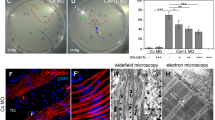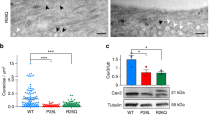Abstract
Mutations in human caveolin-3 are known to underlie a range of myopathies. The cav-1 gene of Caenorhabditis elegans is a homologue of human caveolin-3 and is expressed in both neurons and body wall muscles. Within the body wall muscle CAV-1 localises adjacent to neurons, most likely at the neuromuscular junction (NMJ). Using fluorescently tagged CAV-1 and pre- and post-synaptic markers we demonstrate that CAV-1 co-localises with UNC-63, a post-synaptic marker, but not with several pre-synaptic markers. To establish a model for human muscular dystrophies caused by dominant-negative mutations in caveolin-3 we created transgenic animals carrying versions of cav-1 with homologous mutations. These animals had increased sensitivity to levamisole, suggesting a role for cav-1 at the NMJ. Animals carrying a deletion in cav-1 show a similar sensitivity. Sensitivity to levamisole and locomotion were also perturbed in animals carrying a dominant-negative cav-1 and a mutation in dynamin, which is a protein known to interact with caveolins. Thus, indicating an interaction between CAV-1 and dynamin at the NMJ and/or in neurons.




Similar content being viewed by others
References
Anderson RG (1998) The caveolae membrane system. Annu Rev Biochem 67:199–225
Betz RC, Schoser BG, Kasper D, Ricker K, Ramirez A, Stein V, Torbergsen T, Lee YA, Nothen MM, Wienker TF, Malin JP, Propping P, Reis A, Mortier W, Jentsch TJ, Vorgerd M, Kubisch C (2001) Mutations in CAV3 cause mechanical hyperirritability of skeletal muscle in rippling muscle disease. Nat Genet 28:218–219
Carlson BM, Carlson JA, Dedkov EI, McLennan IS (2003) Concentration of caveolin-3 at the neuromuscular junction in young and old rat skeletal muscle fibers. J Histochem Cytochem 51:1113–1118
Carre-Pierrat M, Grisoni K, Gieseler K, Mariol MC, Martin E, Jospin M, Allard B, Segalat L (2006) The SLO-1 BK channel of Caenorhabditis elegans is critical for muscle function and is involved in dystrophin-dependent muscle dystrophy. J Mol Biol 358:387–395
Chalfie M, Sulston JE, White JG, Southgate E, Thomson JN, Brenner S (1985) The neural circuit for touch sensitivity in Caenorhabditis elegans. J Neurosci 5:956–964
Clark SG, Shurland DL, Meyerowitz EM, Bargmann CI, van der Bliek AM (1997) A dynamin GTPase mutation causes a rapid and reversible temperature-inducible locomotion defect in C. elegans. Proc Natl Acad Sci USA 94:10438–10443
Culetto E, Baylis HA, Richmond JE, Jones AK, Fleming JT, Squire MD, Lewis JA, Sattelle DB (2004) The Caenorhabditis elegans unc-63 gene encodes a levamisole-sensitive nicotinic acetylcholine receptor alpha subunit. J Biol Chem 279:42476–42483
Drab M, Verkade P, Elger M, Kasper M, Lohn M, Lauterbach B, Menne J, Lindschau C, Mende F, Luft FC, Schedl A, Haller H, Kurzchalia TV (2001) Loss of caveolae vascular dysfunction and pulmonary defects in caveolin-1 gene-disrupted mice. Science 293:2449–2452
Fischer D, Schroers A, Blumcke I, Urbach H, Zerres K, Mortier W, Vorgerd M, Schroder R (2003) Consequences of a novel caveolin-3 mutation in a large German family. Ann Neurol 53:233–241
Fleming JT, Squire MD, Barnes TM, Tornoe C, Matsuda K, Ahnn J, Fire A, Sulston JE, Barnard EA, Sattelle DB, Lewis JA (1997) Caenorhabditis elegans levamisole resistance genes lev-1 unc-29 and unc-38 encode functional nicotinic acetylcholine receptor subunits. J Neurosci 17:5843–5857
Fraser AG, Kamath RS, Zipperlen P, Martinez-Campos M, Sohrmann M, Ahringer J (2000) Functional genomic analysis of C. elegans chromosome I by systematic RNA interference. Nature 408:325–330
Galbiati F, Razani B, Lisanti MP (2001) Caveolae and caveolin-3 in muscular dystrophy. Trends Mol Med 7:435–441
Hedgecock EM, Hall DH (1991) Motor vesicles. Curr Biol 1:77–79
Hedgecock EM, Culotti JG, Hall DH (1990) The unc-5 unc-6 and unc-40 genes guide circumferential migrations of pioneer axons and mesodermal cells on the epidermis in C. elegans. Neuron 4:61–85
Hernandez-Deviez DJ, Martin S, Laval SH, Lo HP, Cooper ST, North KN, Bushby K, Parton RG (2006) Aberrant dysferlin trafficking in cells lacking caveolin or expressing dystrophy mutants of caveolin-3. Hum Mol Genet 15:129–142
Herrmann R, Straub V, Blank M, Kutzick C, Franke N, Jacob EN, Lenard HG, Kroger S, Voit T (2000) Dissociation of the dystroglycan complex in caveolin-3-deficient limb girdle muscular dystrophy. Hum Mol Genet 9:2335–2340
Hobert O (2002) PCR fusion-based approach to create reporter gene constructs for expression analysis in transgenic C. elegans. Biotechniques 32:728–730
Hosono R, Kamiya Y (1991) Additional genes which result in an elevation of acetylcholine levels by mutations in Caenorhabditis elegans. Neurosci Lett 128:243–244
Kim YN, Bertics PJ (2002) The endocytosis-linked protein dynamin associates with caveolin-1 and is tyrosine phosphorylated in response to the activation of a noninternalizing epidermal growth factor receptor mutant. Endocrinology 143:1726–1731
Lewis JA, Wu CH, Berg H, Levine JH (1980) The genetics of levamisole resistance in the nematode Caenorhabditis elegans. Genetics 95:905–928
Lipardi C, Mora R, Colomer V, Paladino S, Nitsch L, Rodriguez-Boulan E, Zurzolo C (1998) Caveolin transfection results in caveolae formation but not apical sorting of glycosylphosphatidylinositol (GPI)-anchored proteins in epithelial cells. J Cell Biol 140:617–626
Mariol MC, Martin E, Chambonnier L, Segalat L (2007) Dystrophin-dependent muscle degeneration requires a fully functional contractile machinery to occur in C. elegans. Neuromuscul Disord 17:56–60
McIntire SL, Reimer RJ, Schuske K, Edwards RH, Jorgensen EM (1997) Identification and characterization of the vesicular GABA transporter. Nature 389:870–876
McNally EM, de Sa ME, Duggan DJ, Bonnemann CG, Lisanti MP, Lidov HG, Vainzof M, Passos-Bueno MR, Hoffman EP, Zatz M, Kunkel LM (1998) Caveolin-3 in muscular dystrophy. Hum Mol Genet 7:871–877
Minetti C, Sotgia F, Bruno C, Scartezzini P, Broda P, Bado M, Masetti E, Mazzocco M, Egeo A, Donati MA, Volonte D, Galbiati F, Cordone G, Bricarelli FD, Lisanti MP, Zara F (1998) Mutations in the caveolin-3 gene cause autosomal dominant limb-girdle muscular dystrophy. Nat Genet 18:365–368
Nguyen M, Alfonso A, Johnson CD, Rand JB (1995) Caenorhabditis elegans mutants resistant to inhibitors of acetylcholinesterase. Genetics 140:527–535
Nonet ML, Grundahl K, Meyer BJ, Rand JB (1993) Synaptic function is impaired but not eliminated in C. elegans mutants lacking synaptotagmin. Cell 73:1291–1305
Nonet ML, Saifee O, Zhao H, Rand JB, Wei L (1998) Synaptic transmission deficits in Caenorhabditis elegans synaptobrevin mutants. J Neurosci 18:70–80
Nurrish S, Segalat L, Kaplan JM (1999) Serotonin inhibition of synaptic transmission: Galpha(0) decreases the abundance of UNC-13 at release sites. Neuron 24:231–242
Oh P, McIntosh DP, Schnitzer JE (1998) Dynamin at the neck of caveolae mediates their budding to form transport vesicles by GTP-driven fission from the plasma membrane of endothelium. J Cell Biol 141:101–114
Parton RG, Richards AA (2003) Lipid rafts and caveolae as portals for endocytosis: new insights and common mechanisms. Traffic 4:724–738
Rand JB, Russell RL (1985) Molecular basis of drug-resistance mutations in C. elegans. Psychopharmacol Bull 21:623–630
Rayes D, Flamini M, Hernando G, Bouzat C (2007) Activation of single nicotinic receptor channels from Caenorhabditis elegans muscle. Mol Pharmacol 71:1407–1415
Richmond JE, Broadie KS (2002) The synaptic vesicle cycle: exocytosis and endocytosis in Drosophila and C. elegans. Curr Opin Neurobiol 12:499–507
Scheel J, Srinivasan J, Honnert U, Henske A, Kurzchalia TV (1999) Involvement of caveolin-1 in meiotic cell-cycle progression in Caenorhabditis elegans. Nat Cell Biol 1:127–129
Schmidt A, Wolde M, Thiele C, Fest W, Kratzin H, Podtelejnikov AV, Witke W, Huttner WB, Soling HD (1999) Endophilin I mediates synaptic vesicle formation by transfer of arachidonate to lysophosphatidic acid. Nature 401:133–141
Schuske KR, Richmond JE, Matthies DS, Davis WS, Runz S, Rube DA, van der Bliek AM, Jorgensen EM (2003) Endophilin is required for synaptic vesicle endocytosis by localizing synaptojanin. Neuron 40:749–762
Simmer F, Tijsterman M, Parrish S, Koushika SP, Nonet ML, Fire A, Ahringer J, Plasterk RH (2002) Loss of the putative RNA-directed RNA polymerase RRF-3 makes C. elegans hypersensitive to RNAi. Curr Biol 12:1317–1319
Sulston JE (1983) Neuronal cell lineages in the nematode Caenorhabditis elegans. Cold Spring Harb Symp Quant Biol 48:443–452
Sulston J, Hodgkin J (1988) Methods. In: The nematode Caenorhabditis elegans. Cold Spring Harbor Laboratory Press, New York
Takei K, Yoshida Y, Yamada H (2005) Regulatory mechanisms of dynamin-dependent endocytosis. J Biochem (Tokyo) 137:243–247
Tang Z, Okamoto T, Boontrakulpoontawee P, Katada T, Otsuka AJ, Lisanti MP (1997) Identification sequence and expression of an invertebrate caveolin gene family from the nematode Caenorhabditis elegans. Implications for the molecular evolution of mammalian caveolin genes. J Biol Chem 272:2437–2445
Towers PR, Edwards B, Richmond JE, Sattelle DB (2005) The Caenorhabditis elegans lev-8 gene encodes a novel type of nicotinic acetylcholine receptor alpha subunit. J Neurochem 93:1–9
Towers PR, Lescure P, Baban D, Malek JA, Duarte J, Jones E, Davies KE, Segalat L, Sattelle DB (2006) Gene expression profiling studies on Caenorhabditis elegans dystrophin mutants dys-1(cx-35) and dys-1(cx18). Genomics 88:642–649
Vorgerd M, Bolz H, Patzold T, Kubisch C, Malin JP, Mortier W (1999) Phenotypic variability in rippling muscle disease. Neurology 52:1453–1459
Wakabayashi T, Kitagawa I, Shingai R (2004) Neurons regulating the duration of forward locomotion in Caenorhabditis elegans. Neurosci Res 50:103–111
Woodman SE, Sotgia F, Galbiati F, Minetti C, Lisanti MP (2004) Caveolinopathies: mutations in caveolin-3 cause four distinct autosomal dominant muscle diseases. Neurology 62:538–543
Acknowledgments
We are grateful to Jeremy Skepper for advice on dual colour imaging. We are grateful to Jean-Louis Bessereau for plasmid pJL37 and Andrew Fire for transgenic expression vectors. Some strains were obtained from the Caenorhabditis Genetic Centre. This work was supported by the BBSRC (SP and HP). HAB is an MRC Senior Fellow.
Author information
Authors and Affiliations
Corresponding author
Rights and permissions
About this article
Cite this article
Parker, S., Peterkin, H.S. & Baylis, H.A. Muscular dystrophy associated mutations in caveolin-1 induce neurotransmission and locomotion defects in Caenorhabditis elegans . Invert Neurosci 7, 157–164 (2007). https://doi.org/10.1007/s10158-007-0051-5
Received:
Accepted:
Published:
Issue Date:
DOI: https://doi.org/10.1007/s10158-007-0051-5




